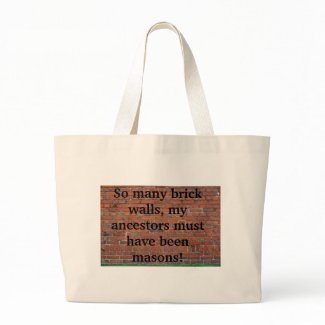My mom asked me a couple weeks ago what I wanted for Christmas. I know she
wasn't expecting me to ask for a DNA test, considering that she thought I
was crazy when I asked for one for my birthday . . . and considering
that I
got one for my birthday. How many DNA tests does a girl
need, anyway? (One (Y-DNA) for each male line that survives, plus one
(autosomal) for herself, of course.)
Other people in our
families tend to think that genealogy is boring, and can't imagine how
delighted we'd be to unwrap a copy of
Evidence Explained on Christmas morning, or to find
A New Genealogical Atlas of Ireland
in our stockings. And so I'm pretty sure that my loved ones are loathe
to get me what I really want, thinking that it's all just too boring
for words.
At the same time, I think that the gifts I
plan on giving this year do a nice job of incorporating family history
in accessible ways that the non-genealogists in my life will appreciate
and not be bored by. So this gift guide will incorporate both gifts for
the genealogist in your life, and gifts genealogists can give to the
"normal" people in their lives. They're things I'm planning on making,
or buying for others, things I'd love to have, things I own and love,
and things I think are cool. They're not all strictly genealogical, but
they all are useful for research, or help incorporate our family
histories into our celebrations and our lives.
Scanners
Wand Scanner - I've had the
Pandigital Handheld Wand Scanner
for several months now, and I never cease to be amazed by its
convenience. It's easy to use, small enough to fit in my purse so I can
carry it to relative's homes
just in case some old photo albums
come out, and I find the quality of the output is great. (I forgot when I
went home this weekend, and I really regretted it! A wand scanner -
don't leave home without it!)
Flip-Pal Mobile Scanner
- I've heard fantastic things about the Flip-Pal Mobile Scanner, but I
don't have one. Between my flatbed scanner and my wand scanner, I feel
that my current scanning needs are pretty well covered. So many
genealogists find it invaluable, though, that I suspect you can't go
wrong getting this for the genealogist in your life. (Especially if she
doesn't have a wand scanner. Every genealogist needs
some kind of
portable scanning technology.) (Note: I am not a Flip-Pal Affiliate. If
you're interested in buying a Flip-Pal Scanner, I encourage you to go
through the link of an affiliate, so that another member of the
genealogy community can benefit from your purchase.)
Books
The beauty of books is that they can be customized to the research interests and existing library of the reader
or
they can be customized to the interest and family history of the
non-genealogist in the family. You have choices. You could get
Evidence Explained by Elizabeth Shown Mills, or
Hey, America, Your Roots are Showing by Megan Smolenyak,
for almost any genealogist. (You could get the latter for almost
anyone, period.) You could tailor your choices to the area of interest
of the recipient, getting
A New Genealogical Atlas of Ireland, Second Edition
by Brian Mitchell, for example, for someone researching in Ireland
(I've been drooling over this one since I was introduced to it at
The Genealogy Event).
You could, of course, choose a relevant history book that's not
genealogy-specific, but that lends context to the work of the
researcher. (Doing most of my research in Brooklyn, I've recently
checked out of the library
Diocese of Immigrants: The Brooklyn Catholic Experience 1853-2003 and
Brooklyn: An Illustrated History.)
You can also look for general interest books (even fiction!)
that relate to the areas of interest of the researcher, or to the
history of your family. These are a great choice for the non-genealogist
in the family, too. Think on family history, family stories, even
legends - you might help prove or disprove that old tale! If, for
example, the high point in your grandfather's life was the time he
pitched to Willie Mays during batting practice when they were in the
Army together (my grandfather was that lucky man!), your father might be
interested in a copy of the most recent Mays biography,
Willie Mays: The Life, The Legend.
There's guaranteed to be a great book out there about almost any
historical person, place, era, or event that intersected your family's
experiences.
DNA Tests
If
you're interested in Genetic Genealogy, it's often worthwhile to take
(or have your relatives take) more DNA tests than your average Joe
Genealogy can afford all at once. If you're inclined to get a
genealogist a relatively big-ticket item, discussing their interest in
DNA testing might be a great way to go.
FamilyTreeDNA is having their annual sale, so now's the time to buy! (But always find out what company your favorite genealogist prefers to test with first.) I could get one of these every Christmas for the next 5 years, and it wouldn't be too many.
Photo Gifts
Any
gift that includes photos, past or present, is, in essence, a family
history gift. These are great gifts that can be appreciated by both
genealogists and those not genealogically inclined relatives whose
interests you're trying to spark. Any variety of picture frame might
work, depending on your idea for a project, but a few ideas are
Christmas ornament frames like these, or a set of
photo coasters like these, which I think would look great filled with old black and white or sepia-toned pictures. Be sure to use copies of old photos,
never originals!
(I wish I had some great pictures to share, but while these are both
ideas I've had for years, they're not ideas I've put
into practice yet. I'm looking at a photo collage on the wall of my
mother's house right now, that I made her as a Mothers' Day gift a
number of years ago, but I won't be sharing it on the blog, because it
includes both pictures of relatives who prefer not to appear on the
internet, and pictures of me in the throes of an adolescence that I'd
rather didn't appear in the living room, much less on the internet.
Nonetheless, I can attest that it was well-received.)
Education
Genealogists
love education. They love conferences, they love reading, they love
lectures, they love webinars, they love round tables and working groups
and societies. But genealogy as a hobby isn't cheap, and the pursuit of
genealogical excellence is even less so, so most of us have to be choosy
about what we join and attend. Consider getting your favorite
genealogists membership in a local genealogical society, or one in the
area in which they research, or else in one of the major national
societies, like
NEHGS,
NYG&B,
SCGS, or
NGS.
Consider buying tickets to a local conference, or offer to sign them up
for an interesting webinar. (Just remember how we started this
discussion with a distinction between what genealogists find interesting
and what so-called normal people find interesting.) Try a subscription
to a print magazine, like
Family Tree Magazine, or an online resource, like the
Plus Edition of Dick Eastman's Online Genealogy Newsletter.
Research
If
there's one thing that genealogists love more than they love education,
it's research. I've always thought that records repositories should
offer gift certificates (imagine finding in your stocking vouchers for 2
BMDs, a probate record, and a declaration of intent!), but despite my
prodding, it never caught on. Still, there are other ways you can give
someone the gift of research. A subscription to
Ancestry.com,
GenealogyBank, or
Fold3
is an obvious way, but you could also do things that are a little less
tangible, but could be more helpful. Offer to watch the kids for a day
so he or she can have some uninterrupted hours at the local Family
History Center. Heck, if you're up for it, offer to accompany her to the
FHC, to help read microfilm. (Don't worry, she'll tell you're looking
for. She may be scanning a large series of marriage records for every
instance of the name Quinn in hopes of finding her
great-great-grandparents, Hugh and Mary. A second set of eyes might mean
the difference between spending a few weeks on a record set and
spending
many weeks on it!)
Organization
Genealogist
might not enjoy organization quite as much as they enjoy research and
education, but they know that it's just as important, if not more so.
There are a couple of different organizational methods that genealogists
use, and any of them could be the basis for a good gift.
There's genealogy software, like
RootsMagic,
Reunion, or
Family Tree Maker. I can recommend FTM for Mac (version 2), which is what I use and which is the version I linked to, but your preference may differ, based on your needs and your operating system.
And then there are the old-fashioned, low-tech organizational tools that are essential for every genealogist,
including
the ones who use software and online programs. File folders, file
cabinets, binders, page protectors, etc. These, I will grant you, are
not particularly exciting, but they're useful. (I'm down to 1 remaining
file folder at my house, and definitely in the market for more!) Check out
Gaylord or
University Products for archival and preservation-quality folders and boxes.
Genealogy Gear
I'm going to throw in a plug for my own small genealogy shop on Zazzle.com,
Wear You Came From.
Check it out for everything from "#1 Ancestor" shirts for genie
grandparents to bowls proclaiming "My family tree has bark!" for the
furriest members of the family. There are undoubtedly also other great
genealogy-inspired shops on
Zazzle.com, as well as on
CafePress, that you can look to for other designs, if nothing at my shop strikes your fancy. (But check out
Wear You Came From first!)
Family Tree
Last year, I bought
a set of beautiful family tree charts from the Etsy shop
Fresh Retro Gallery.
I used one to make a family tree of my maternal side of the family,
which I gave to my grandparents, and my husband is now working on the
other, which will be given to his parents as a Christmas present this
year. (I have complete confidence that they, like most of my blood
relatives, never so much as glance at this blog, so I don't mind saying
so publicly.) My in-laws haven't gotten their gift yet, but my
grandmother loved hers, and it's now hung prominently in their home.
Most people are glad to hang a beautiful, "completed," family tree in
their homes, even if they wouldn't be nearly as interested in the
research that went into it.
Scrapbooking
Not
all genealogists are crafty, or fans of scrapbooking. For a long time I
thought that I wasn't. (Two weeks ago, at my parents' house, I stumbled
across not 1, not 2, but 3 forgotten scrapbooks that I had made when I
was in high school and college. Apparently, I was actually
quite the scrapbooker at one point!) If
you're a genealogist with that scrapbooking gene, a well-done scrapbook
about a family, person, or event in your family's history makes a
beautiful gift for a relative. If you're interested in digital
scrapbooking, try the MyMemories Suite. It's the tool I used to create
the header for this blog recently, and it can make wonderful scrapbooks,
as well. If you plan to buy
MyMemories software, you can use the exclusive coupon code
STMMMS25444 to get a discount on your purchase. Watch this space for a full review and a giveaway in the coming weeks!
Family Stories
The gift that I'm most looking forward to giving this is year is a compilation of family stories that I wrote up and had published, using
Lulu.com. Before my grandfather passed away, he used to come over for dinner frequently, and often regaled us with stories of different eras and events of his life. One night, my mom remarked, "Someone should be writing these down!" and I resolved to do so, though I didn't tell anyone about it. At the time, I was in high school, and later college, and it was before I was officially interested in genealogy - but I was, thank goodness, interested enough to write down notes after Pop left each evening. (I wasn't perfect - my most frustrating oversight is a note that says "meeting Nan," to remind myself to write down the story he'd told about meeting my grandmother, which I never got around to. I've forgotten the story, as has apparently everyone else who heard it that night, and the story of how they met seems to have been lost to history, though I'm on a mission to ask everyone who might know.) The book - about 20 pages, with illustrations using scanned family photos - is a gift for my dad, but I've also ordered a copy for each of my aunts, and will make it available via Lulu.com to any other relatives who want a copy, in service of a strategy I've dubbed preservation through dissemination. The more copies of something that exist, the more likely it is to survive for future generations. (Again, I know almost no one in my family reads this blog, so I have no qualms about revealing their gifts here. If any of you happens to check in, I'd appreciate your discretion.)
Family Cookbook
This wasn't a Christmas gift, but it was one of the best gifts I've ever gotten. When my cousin got married several years ago, she asked for a book of family recipes, and her sister enlisted the help of the whole family in compiling one. When I got married 18 months ago, my sister piggybacked off of the recipes our cousin had already collected, adding to them recipes from the other side of the family, from my husband's family, and from our friends. When another cousin got married just this month, we piggybacked again, adding recipes from her dad's side of the family as well as from her in-laws. The book keeps growing, and it's a wealth of information, delicious recipes, and family history. Of course, there are somewhat more modest ways to go about this project, too (the most recent version nearly burst the spine of the book it was in!) I could envision taking a dozen or so of a family's favorite Christmas foods and creating a family Christmas cookbook, or requesting a single recipe from each contributor (not half a dozen each, which is what some of my relatives tend to share).
I hope you can take away from this post some creative ideas about how to share your research and your family's history with your loved ones this holiday season, as well as a bit of insight into the mind of a genealogist and how to shop for him or her!
Disclosure: This post contains Amazon.com affiliate links. This means that if you choose to make a purchase from Amazon after clicking one of these links, I will receive a small portion of your purchase price as a commission. I personally make a point of starting my Amazon shopping through the affiliate links of bloggers and friends whenever possible, so that large corporations are not the only beneficiaries of my purchases, and encourage others to do the same, regardless of whether they use my affiliate links or another blogger's.
























